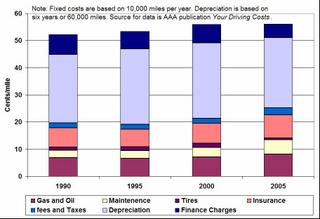Chart of the Month: August 2005
I got the following question from one of the readers (paraphrased):
 (click on chart for a larger image).
(click on chart for a larger image).
The numbers in the chart are not exact, specially because the 1990-2000 data has been adjusted at 1999 $ levels, where as 2005 numbers are in current dollars. The main point of the chart, however, is to show that gas and oil costs are a relatively small cost of overall driving costs. This may help explain, in part, why consumers will choose to buy a big vehicle with a big discount even when gas prices are quite high (think July 2005 auto sales).
Of course, at Three dollars a gallon, gas and oil costs are no longer less than 15% of the overall driving costs. Even at three dollars a gallon, cost per mile of a 25 miles per gallon vehicle is 12 cents, up from 8 cents per mile at 2 dollar a gallon gasoline. Yet, it constitutes no more than 20% of the overall driving costs. As I noted earlier, I expect the prices to be around 3 dollars for a few weeks before settling down to $2.60 a gallon.
Does this provide a large incentive for American consumers to change vehicle purchasing behavior? On a rational basis, I would say NO. Consumer choices are, however, driven by factors beyond economic considerations. Emotional appeal of a high fuel economy vehicle may be high right now, and I am all for people buying more fuel efficient vehicle.
Our current mileage reimbursement rate is .$405 per mile. We want it to reflect the current gasoline prices. What would be an equitable rate to request and expect while prices are currently $3.19 per gallon for regular gasoline in our area?I am not inclined to answer this question directly. I will, however, post a chart showing the costs involved in driving an automobile. The numbers are based on AAA's Your Driving Costs.
 (click on chart for a larger image).
(click on chart for a larger image).The numbers in the chart are not exact, specially because the 1990-2000 data has been adjusted at 1999 $ levels, where as 2005 numbers are in current dollars. The main point of the chart, however, is to show that gas and oil costs are a relatively small cost of overall driving costs. This may help explain, in part, why consumers will choose to buy a big vehicle with a big discount even when gas prices are quite high (think July 2005 auto sales).
Of course, at Three dollars a gallon, gas and oil costs are no longer less than 15% of the overall driving costs. Even at three dollars a gallon, cost per mile of a 25 miles per gallon vehicle is 12 cents, up from 8 cents per mile at 2 dollar a gallon gasoline. Yet, it constitutes no more than 20% of the overall driving costs. As I noted earlier, I expect the prices to be around 3 dollars for a few weeks before settling down to $2.60 a gallon.
Does this provide a large incentive for American consumers to change vehicle purchasing behavior? On a rational basis, I would say NO. Consumer choices are, however, driven by factors beyond economic considerations. Emotional appeal of a high fuel economy vehicle may be high right now, and I am all for people buying more fuel efficient vehicle.


0 Comments:
Post a Comment
<< Home